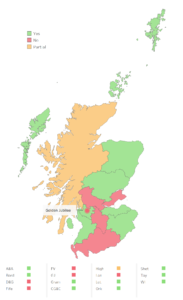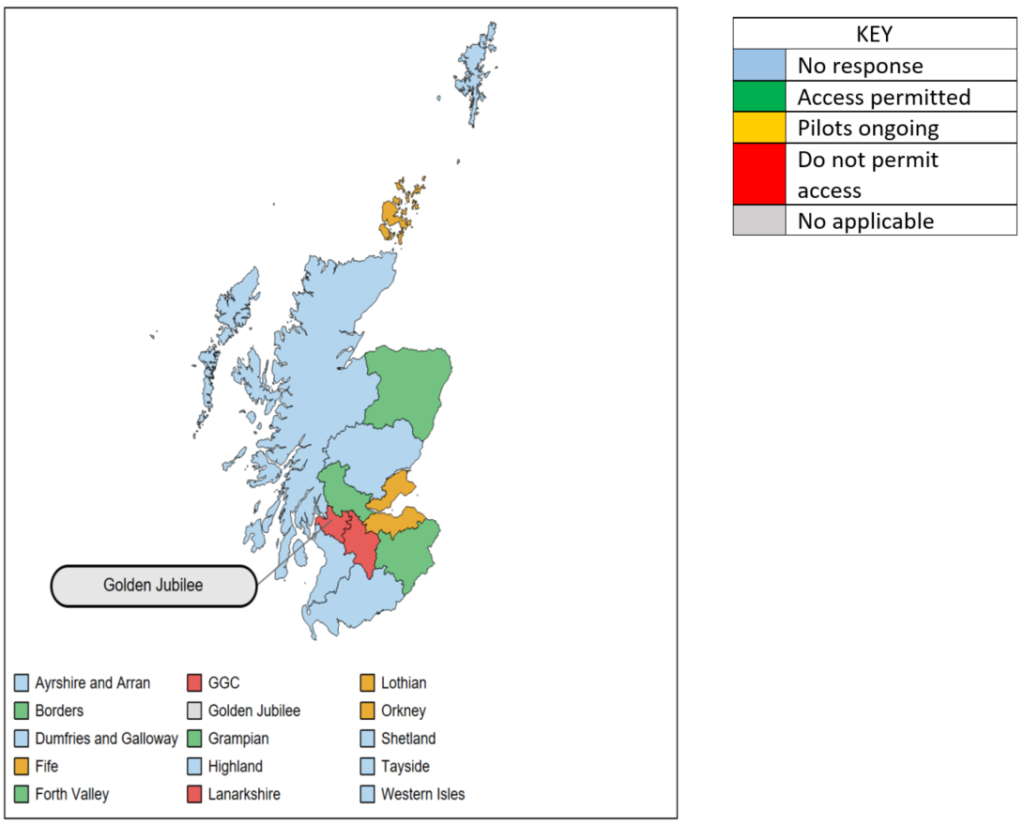Various work has been done through SCIN with regards to Direct Access to Imaging over the years. Please see the year below to see the work that was undertaken in that year.
2023
Direct Access to CT of Chest/Abdomen/Pelvis for Patients with Unidentified Suspected Malignancy
A survey was conducted in 2023 via the Scottish CT Special Interest Group to update on the national position at the request of the various committees within Scottish Government..
The results are shown below on the map and show which Health Boards provide full, partial or no services.

Scottish referral guidelines for suspected cancer
Guidance for Primary Care Clinicians
Protocol for Primary Care Clinicians
These revised guidelines aim to facilitate appropriate referral between primary and secondary care for patients whom a GP suspects may have cancer. The guidelines should help to identify those patients who are most likely to have cancer and who therefore require urgent assessment by a specialist. Equally, it is intended that the guidelines will help to identify patients who are unlikely to have cancer and who may appropriately be observed in a primary care setting or who may require non-urgent referral to a hospital.
2020
A simple survey was conducted via the Scottish CT Special Interest Group to respond to a question relating to a project on Early Brain Tumour Diagnosis through the Brain Tumour Charity. The results of this survey can be found here.
2019
Direct Access to CT of Chest/Abdomen/Pelvis for Patients with Unidentified Suspected Malignancy
A simple survey was conducted via the Scottish CT Special Interest Group to update on the national position at the request of the various committees within Scottish Government..
The group was asked to identify if GPs in their Board were permitted to refer for the above imaging in 2019. The results are shown below on the map. Several Boards indicated that they had permitted GP access prior to 2019. Four Boards do not permit GP referral. Two Boards had piloted access and are working towards this introduction into practice.

2018
Direct Access to CT of Chest/Abdomen/Pelvis for Patients with Unidentified Suspected Malignancy
A simple survey was conducted via the Scottish Imaging Managers Group to update on the national position at the request of Scottish Government.
The group was asked to identify if GPs in their Board were permitted to refer for the above imaging in 2018. The results are shown below on the map.
Several Boards did not respond.
Three Boards permit GP access – Borders, Grampian and Forth Valley.
Two Boards indicated they did not permit access.
Fife, Lothian and Orkney were in the process of piloting access arrangements.

2017
An audit of the implementation of the 2015 recommendations was undertaken in 2017. This audit had a response rate of only 4 responding Boards(6 responses). This was taken to the Diagnostic Steering Group for guidance of further steps. Concurrently GP Direct access to CT for patients with unidentified suspected malignancy was being discussed by various committees within Scottish Government.
A copy of the report may be found here.
2015
Introduction
This group has worked collaboratively with GP colleagues and the Scottish Cancer Taskforce to develop a national pathway for GP access to CT Chest/Abs/Pelvis for patients with unidentified suspected malignancy. This is currently being assessed by the Diagnostic Steering Group and Scottish Cancer Taskforce
Report
Direct Access to CT of Chest/Abdomen/Pelvis for Patients with
Unidentified Suspected Malignancy
Scottish referral guidelines for suspected cancer
These revised guidelines aim to facilitate appropriate referral between primary and secondary care for patients whom a GP suspects may have cancer. The guidelines should help to identify those patients who are most likely to have cancer and who therefore require urgent assessment by a specialist. Equally, it is intended that the guidelines will help to identify patients who are unlikely to have cancer and who may appropriately be observed in a primary care setting or who may require non-urgent referral to a hospital.